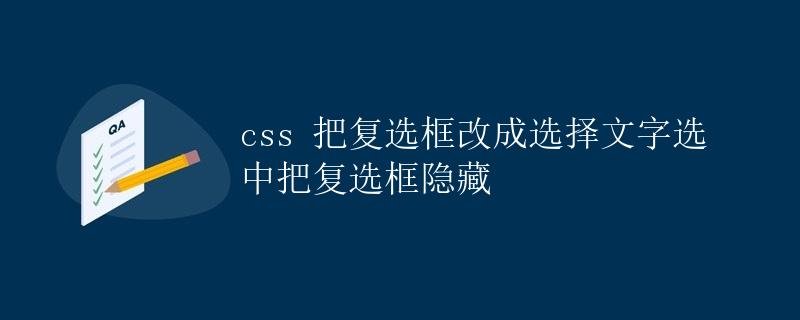CSS changes the checkbox to select text and hides the checkbox
CSS changes the checkbox to select text and hides the checkbox

In web development, we often use checkboxes to enable user selection. However, sometimes we want to hide the default checkbox style and instead require the user to click the text to select it. This article will detail how to achieve this effect using CSS.
Basic Principle
In HTML, the style of a checkbox (<input type="checkbox">) is determined by the browser’s default style, typically a small square with an adjacent text label. However, we can use CSS selectors and pseudo-classes to change this default style, so that users actually click the checkbox when they click the text.
Implementation steps
1. Hiding the Default Checkbox
First, we need to hide the default checkbox, which can be achieved by setting display: none;. However, we need to use another method to display the user’s selection status instead of the checkbox, such as a pseudo-element or a <span> tag.
input[type="checkbox"] {
display: none;
}
.checkbox-label {
display: inline-block;
position: relative;
padding-left: 25px; /* Leave space for pseudo-elements or span tags */
}
.checkmark {
position: absolute;
top: 0;
left: 0;
width: 20px;
height: 20px;
background-color: #eee;
}
/* Checked state styles */
input[type="checkbox"]:checked + .checkmark {
background-color: #2196F3;
}
2. Adding a pseudo-element or <span> tag
Next, we need to add a pseudo-element or <span> tag to simulate a checkbox and change its style to indicate the selected state when the user clicks it.
.checkbox-label::before {
content: "";
display: inline-block;
position: absolute;
top: 0;
left: 0;
width: 20px;
height: 20px;
border: 1px solid #ccc;
}
input[type="checkbox"]:checked + .checkbox-label::before {
background-color: #2196F3;
}
3. HTML Structure
Finally, in HTML, we need to arrange the checkbox and text appropriately to ensure that the checkbox is selected when the user clicks the text.
<label class="checkbox-label">
<input type="checkbox">
Item 1
</label>
<label class="checkbox-label">
<input type="checkbox">
Item 2
</label>
<label class="checkbox-label">
<input type="checkbox">
Item 3
</label>
Running Results
Through the above steps, we can achieve the effect of hiding the default style of the checkbox and selecting it when the user clicks the text. The sample code has already set the styles for the checked and unchecked states of the checkbox. Users can customize the styles as needed.